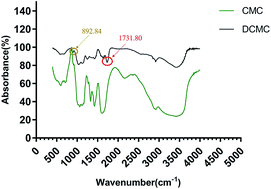Development and characterization of bladder acellular matrix cross-linked by dialdehyde carboxymethyl cellulose for bladder tissue engineering†
Abstract
In order to address the disadvantage of rapid degradation and serious immune response of bladder acellular matrix (BAM) tissues in clinical application, in this study, oxidized carboxymethyl cellulose (DCMC) was developed to replace glutaraldehyde (GA), a most common synthetic crosslinking reagent in clinical practice, to fix BAM tissues for lower cytotoxicity. The aim of this work was to evaluate feasibility of DCMC as a crosslinking reagent for BAM fixation and developing DCMC fixed-BAM (D-BAM) tissues for tissue engineering. For the preparation of DCMC, the results showed that when DCMC was prepared using a specific concentration of sodium periodate solution (the mass ratio of NaIO4/CMC is 1 : 1) and a specific reaction time (4 hours), its cytotoxicity was the lowest and its fixation effect was better. The critical crosslinking characteristics and cytocompatibility of optimum D-BAM tissues were also investigated. The results demonstrated that DCMC-fixation (especially 30 mg ml−1 DCMC-fixation) not only formed stable cross-linking bonds but also preserved well the original ultrastructure of the BAM tissues, which simultaneously increased the mechanical strength and capacity of the enzymatic hydrolytic resistance. The DCMC-fixation could also reduce the expression of α-Gal in BAM tissues and preserve the useful growth factors such as GAGs, KGF and TGF-β in bladder tissues. In addition, 30 mg ml−1 D-BAM tissues had excellent cytocompatibility. Moreover, it could stimulate the secretion of PDGF and EGF from seeded bladder transitional epithelial cells (BTECs), which is a critical feature for further re-epithelialization. Its anti-calcification ability was also prominent, which is necessary in bladder repair. The present studies demonstrated that DCMC could be a potential biological crosslinking agent for BAM fixation due to its excellent crosslinking effects, and the D-BAM tissues were suitable to be used as a substitute for the bladder due to their resistance to enzymatic degradation, anticalcification and cytocompatibility.



 Please wait while we load your content...
Please wait while we load your content...